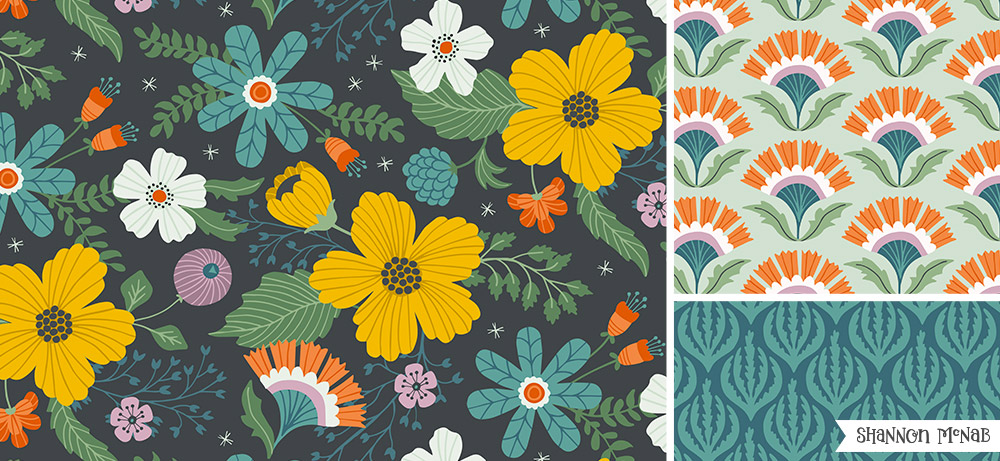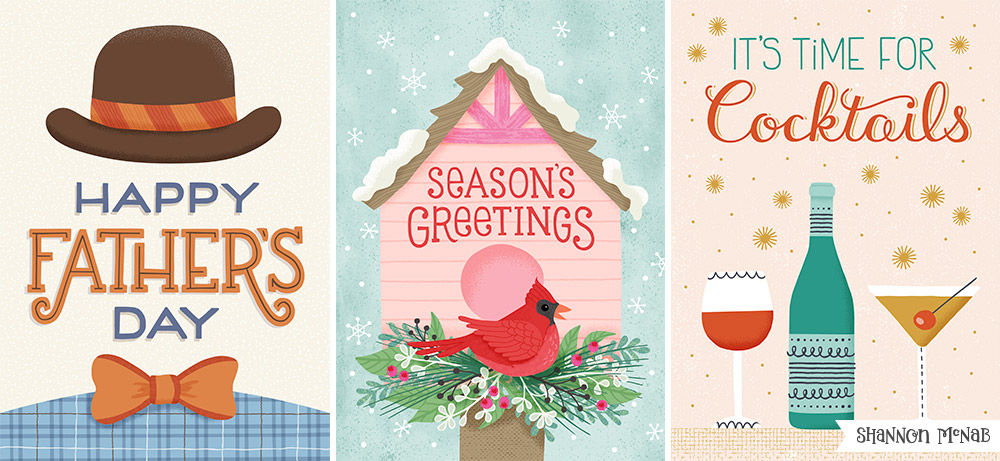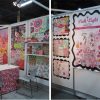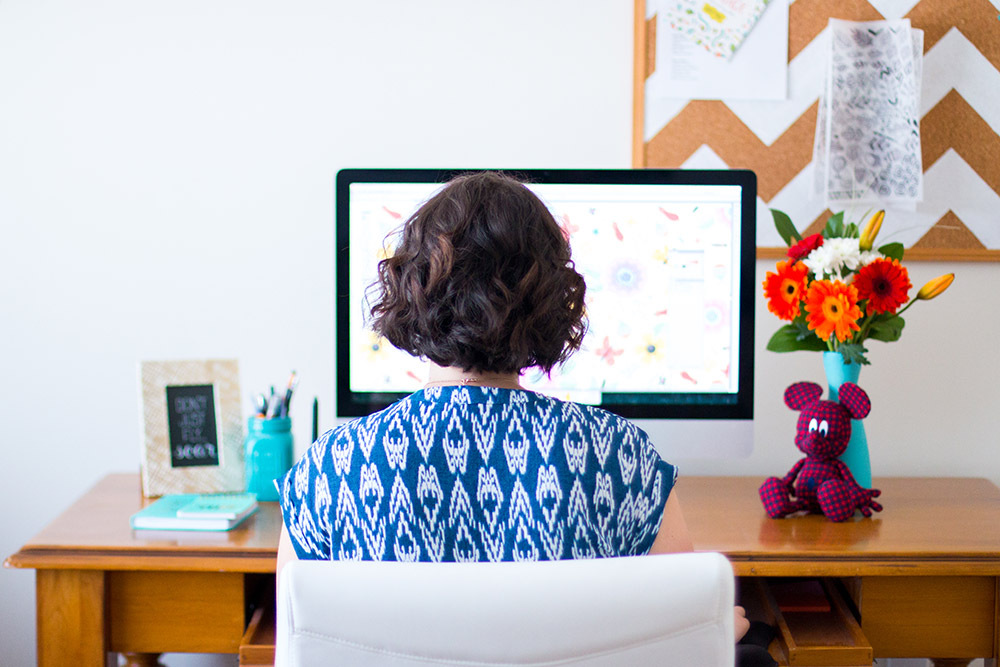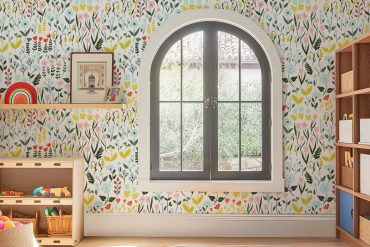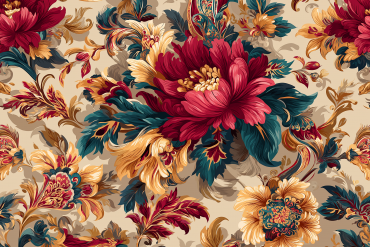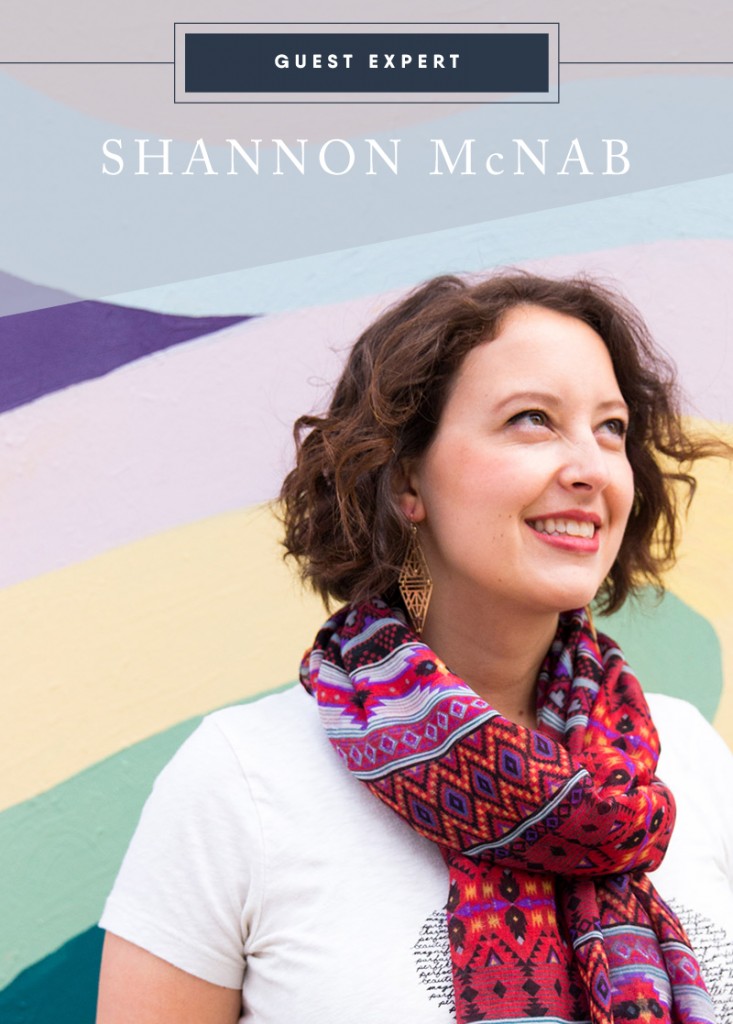
Please tell us a bit about your design background and career path.
My love affair with surface design started in graduate school at Savannah College of Art & Design when I took a textile class on a whim while working towards a degree in graphic design. After graduating, I worked as a freelance graphic designer, followed by a job in the e-commerce design department at Pottery Barn.
While working there, I couldn’t shake the feeling that I was meant for something different – and I missed making patterns. So while working full-time, I started creating patterns at night. In 2010, I took a leap of faith and started selling them online to digital scrapbookers as that industry was just starting to take off.
My online business continued as a side hustle until the summer of 2013, when I quit corporate design and started working for myself full-time. Eventually, my digital scrapbook designs landed me projects in the paper scrapbook industry with companies like Echo Park Paper and Becky Higgins. Those client projects gave me the final push I needed to broaden my horizon, so I retired from dig design in 2016 to pursue surface design.
Tell us about your current freelance design business. What does a typical day look like for you? What are the different hats you wear?
I don’t really have a typical day, instead I’d say I have a typical week. I’m a bit of a planning/organizing nut, so I like to designate certain days for particular tasks.
Three days per week are dedicated to client work and designing for my portfolio, one day for administrative tasks like emailing new contacts, researching companies, and marketing, and one day for the educational side of my business where I mentor designers through online classes, consultations, and a private Facebook group. I really love designing AND teaching as it fuels different parts of my personality.
Now that you have two Surtex shows under your belt, what advice do you have for designers who are considering exhibiting for the first time at Surtex or another trade show? What do you wish someone had told you before your first trade show?
Make sure you have a plan in place in the months after the show. I totally winged it following my first show at Surtex in 2017; after sending the initial follow up emails, I made a crucial mistake of not continuing to follow up regularly. This business is definitely a long-term game, so it’s important to have a strategy on how you’ll contact clients for months (and years) after meeting them at the show.
Another tip I’d give first timers is to make friends with the designers around you at the show, even months before it begins, if possible. The show will be a lot less lonely and boring if you have someone you can chat with and who knows what you’re going through. There’s something so special about the camaraderie between exhibitors and I’m lucky to have made a lot of friends in this industry from it.
How much time would you say you put into trade show prep & follow-up? (could be a percentage of your working hours or maybe break up by time spent each day/week/or month?)
Trade show prep ramps up as you get closer to the show, especially in the three months before. During those final months, I’d say I probably spend about 50% of my time dedicated to prep. Also, everything for the show needs to be designed and ordered well in advance, so I recommend keeping a detailed timeline so you know when each task needs to be completed.
For follow up, the first three weeks are definitely the busiest, as most of my office time is dedicated to sending out emails to all the contacts I collected at the show. I do have a system for how to strategically follow up and it’s something I’ll share with you during my live presentation – it really helps avoid overwhelm which is so incredibly common post-show.
What do you enjoy most about trade shows? What do you find most challenging about them?
Having one-on-one, in person interactions with clients and designers is my absolute favorite part about trade shows. So much of our lives as surface designers happens behind a desk, often alone in an office, so I relish any opportunity to talk with people in the industry face to face.
The biggest challenge is probably how physically and emotionally draining a trade show can be. Prior to Surtex, I had only been to trade shows as an attendee, so I was surprised at just how much more exhausting it is to be an exhibitor. And while exhibiting has been the single most impactful thing to help propel my career, putting my art out on display and talking about myself for 3 full days is difficult.
That’s why it’s important to be gentle with yourself in the weeks leading up to a trade show. My husband and I usually take a short trip a few weekends beforehand so I can relax and not think about the show for a few days. And then post show, I don’t put any pressure on myself to immediately make new art. Instead, it’s important to focus your energy on follow ups and giving yourself some time to recharge.
It’s no secret that many of us artists are introverts, and I know you have described yourself as such in the past. What advice do you have for the introverted among us as far as putting your work out into the world, reaching out to clients, attending trade shows, and other elements of a freelance design career that might make introverts hesitant to launch their own businesses?
You’re right – I like to call myself an extroverted introvert. For example, I hate talking on the phone, but I enjoy talking one-on-one in person. Like I would rather drive 3 hours in a car to talk to someone in person than have a phone call with them. But that’s just not realistic and sometimes a phone call is required, so I suck it up and remind myself that my business won’t grow if I always stay in my comfort zone.
As far as advice, I’m a big advocate on rewarding yourself after an important or uncomfortable task is completed. The reward doesn’t have to be big and should be something that motivates you to get the job done. A few of the rewards I’ve given myself in the past are a week off from work, purchasing a few new art supplies, and even the occasional margarita from my favorite Mexican restaurant down the street.
It’s important to remember that certain tasks you may not enjoy can help you and your business thrive. If you can keep that in mind and find a way to stay motivated, those tasks will feel less daunting.
What have been some of the challenges you have faced throughout your design career and how have you overcome them?
When I first made the transition to surface design, I had a huge problem with confidence in my illustration abilities. In my previous years as a digital scrapbook designer, I focused primarily on patterns, so I had no stand alone illustration work in my portfolio. Overcoming my lack of confidence took a LOT of practice, coupled with a “fake it til you make it” strategy.
Even when I first exhibited at Surtex in 2017, my portfolio was still about 80% patterns and 20% illustrations, yet I promoted myself as both a pattern designer and illustrator. Of course I wasn’t entirely comfortable describing myself as an illustrator at the time, but I knew it was important for my career to be receptive to all types of commissioned work.
The main takeaway here is to always work on your craft as it helps to not only improve your skills, but can provide a boost to your confidence as an artist as well.
What advice have you received in your career that has stayed with you or influenced you?
I attended a retreat for female business owners a few years ago and one of the speakers said something that really resonated with me: “Just because you CAN do something, doesn’t mean you SHOULD”.
As someone who has a large variety of creative interests, there have been times when I’ve wanted to expand my business to pursue them. But just because I could sell my own branded products or start a Creative Market shop full of hand lettered fonts doesn’t mean I should.
Every business decision you make, should be in service of your long term creative goals. Goal setting is actually something I like to talk about a lot – I even wrote a blog post earlier this year about how to set goals that will actually stick.
Your series of Surtex blog posts were invaluable to us as we prepared for our first trade show earlier this year. Can you give us a quick preview into the training you will be offering to our Textile Design Lab members? What can people expect to learn?
I’m so happy to hear that! I started my Surtex blog series because I had such a hard time finding information about exhibiting as a first timer. I really enjoy talking to designers about the show and I’m very excited to be sharing some insights with you this month.
In my live session, I’ll be talking about what to do after a trade show to maximize your success. Not only will I share my strategy of following up with client leads, but I’ll also discuss the importance to editing and adjusting your portfolio to make it work even harder for you. My hope is that you’ll be ready to hit the ground running after your next trade show.
Textile Design Lab members can join us for Shannon’s Live Training on Tuesday, September 25th. Not a member? Get started here.


